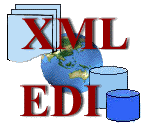|
ViewTouch is implementing a bold, new way of using the internet and browser technology to make it far easier than ever before to view your company's remote site data and directly manage the infosystems in place at your company's remote locations. XML (Extensible Markup Language) and HTML (Hypertext Markup Language) make universal connectivity and remote management a reality today!
|
The
E Business Framework: The XML/EDI Group is working to marry the
EDI and XML standards to create a new document interchange language that
transcends the limitations of EDI through the use of XML, while maintaining
backward compatibility with "vanilla" EDI documents. It will also extend
the usefulness of EDI, since XML/EDI will enable EDI documents to be read
by any XML-capable browser, as well as by dedicated XML/EDI applications.
With the addition of XML, EDI documents will not only be able to carry data about transactions between companies -- but they will also be able to carry routing, workflow, and processing information within themselves. XML/EDI documents will be self-describing, so that new document types can be sent and interpreted without the need to agred interpreted without the need to agree ahead of time on a standard document definition. And XML/EDI documents will even be able to include Java or JavaScript code (or links to server-side code) that will enable them to route and process themselves. Here's a link to our internal XML process.
 HTTP
(Hypertext Transfer Protocol) has been in use by the World Wide
Web global information initiative since 1990. HTTP is an application-level
protocol for distributed, collaborative, hypermedia information systems.
It is a generic, object-oriented protocol which can be used for many tasks,
such as name servers and distributed object management systems. HTTP
(Hypertext Transfer Protocol) has been in use by the World Wide
Web global information initiative since 1990. HTTP is an application-level
protocol for distributed, collaborative, hypermedia information systems.
It is a generic, object-oriented protocol which can be used for many tasks,
such as name servers and distributed object management systems.
ViewTouch Networking is TCP-based. All network activity between the back-office host and the intranet displays and even communications with kitchen, bar and expediter printers is TCP-based. TCP networking and IIOers is TCP-based. TCP networking and IIOP make it possible to connect to databases located anywhere, inside or outside a particular organization. According to Mark Andreesen of Netscape, "The next shift catalyzed by the Web will be the adoption of enterprise systems based on distributed objects and IIOP. In a full-service intranet different operating systems need to talk to each other, Java needs to talk to C++ code on the back-end system, and different applications need to communicate using open standards. We expect that over the next few years IIOP will become as ubiquitous as HTTP and CGI." |
 Imagine
that you have restaurants in Miami, Helsinki and Philadelphia, but offices
in Colorado. You've just finished email exchanges with your managers, but
now need to make price changes, to view and compare restaurant performance
data and post new info for your kitchen staffs. No matter where you are,
if you have Internet access you have everything you need to do this and
more - NOW! Because it's Internet-based, there's no long distance telco
charges, no file management commands or user interaction necessary because
it's all being done transparently via the Internet. Hall being done transparently via the Internet. How's THAT for world-wide
universal connectivity?! There's only one company in the world that is
shipping a proven, multiuser, high-resolution graphic server that can drive
all of the graphic terminals in your restaurant while its being remotely
accessed and managed by your office. Only one company in the world can
directly support your remote POS system and won't charge you extra for
it, and that's ViewTouch.
Imagine
that you have restaurants in Miami, Helsinki and Philadelphia, but offices
in Colorado. You've just finished email exchanges with your managers, but
now need to make price changes, to view and compare restaurant performance
data and post new info for your kitchen staffs. No matter where you are,
if you have Internet access you have everything you need to do this and
more - NOW! Because it's Internet-based, there's no long distance telco
charges, no file management commands or user interaction necessary because
it's all being done transparently via the Internet. Hall being done transparently via the Internet. How's THAT for world-wide
universal connectivity?! There's only one company in the world that is
shipping a proven, multiuser, high-resolution graphic server that can drive
all of the graphic terminals in your restaurant while its being remotely
accessed and managed by your office. Only one company in the world can
directly support your remote POS system and won't charge you extra for
it, and that's ViewTouch.
